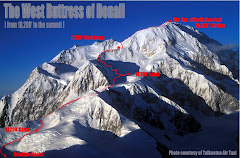Climbing Denali is a serious endeavor with big mountain weather, geography and acclimatization issues. The following itinerary represents an outline of what the Denali Ice Agers Expedition 2010 team members can expect. The Mountain Trip guides know the mountain and may elect to stray from this itinerary in order to give the team the best possible shot at getting to the summit and safely returning. Injuries and frostbite are not an option.
June 18th is Day 1. Please keep in mind that subsequent days could vary on the calendar depending on weather and other factors.
DAY 1: MEET IN ANCHORAGE. Team Meeting for expedition review and equipment check.
DAY 2: TRAVEL TO TALKEETNA AND FLY ON TO THE GLACIER. Team members will travel by shuttle the several hours to Talkeetna where they will register with the National Park Service and obtain their climbing permits prior to flying on to the glacier. Weather permitting, the team will fly into the Kahiltna Glacier at 7,200 feet that afternoon. Once on the glacier, everyone will pitch in to get Base Camp established.
DAY 3: CARRY SUPPLIES TO CAMP 1. Departing base camp, the team will drop down the infamous Heartbreak Hill and onto the broad Kahiltna glacier. The goal is to carry loads to the site of Camp 1 at 7,800 feet, near the junction with the NE Fork of the Kahiltna Glacier. This is a moderate carry of about nine miles round-trip and is a good shake-down for the upcoming days. Depending on the team and weather, the team may or may not return to Base Camp. Throughout the expedition, the Denali Ice Agers will follow the “climb high, sleep low” technique, for better acclimatization, however the altitude difference between Base Camp and Camp 1 is minimal enough to permit a “single-carry” on this stretch. The team may also choose to do their climbing early in the morning to avoid the excessive heat and soft snow conditions on the Lower Glacier. In June, there is 24 hours of daylight.
DAY 4: MOVE REMAINING SUPPLIES AND ESTABLISH CAMP 1. (If the team double carries to Camp 1.)
DAY 5: HAUL LOADS UP TO KAHILTNA PASS. The team will head out of Camp 1 and carry loads up Ski Hill. Several options exist for camp sites between 9,000 and 11,000 feet, depending upon weather and snow conditions. This is a moderately difficult carry of 7-9 miles round-trip, with 3,000 feet of elevation gain and a return to Camp 1 for the night.
DAY 6: MOVE EVERYTHING TO CAMP 2. Camp is often in the 11,200’ basin at the base of Motorcycle Hill. This is an incredibly beautiful camp that basks in alpen glow when the sun travels around the north side of the mountain.
DAY 7: BACK-CARRY DAY. This is an “active rest day” during which the team drops back down and pick up the cache left down near Kahiltna Pass. It also helps give team members another day to acclimatize before moving higher.
DAY 8: HAUL LOADS AROUND WINDY CORNER (13,300 FEET). Steep snow climbing up Motorcycle Hill rewards the climbers with spectacular views. The total distance is four miles round trip with over 2,000 feet of elevation gain. Climbing with crampons and ice axe gets the team around Windy Corner where the upper Mountain comes into full view.
DAY 9: MOVE CAMP TO 14,200 FEET. Moving to Camp 3 is a long, hard day. Loads are getting lighter but the air is getting thinner. Regardless, the team will have to fortify this camp due to the possibility for severe weather. Climbers cut blocks of compressed glacier snow to build walls around their tents.
DAY 10: BACK-CARRY DAY. This is another “active rest day,” during which the team will descend from Camp 3 to the Windy Corner cache and bring everything up to 14,200 feet.
DAY 11: CLIMB UP THE HEADWALL TO THE RIDGE. The team will cache supplies on the ridge and return to 14,200 feet. Climbing up the Headwall (fixed lines run from 15,500 to 16,100 feet) with a heavy pack is one of the more strenuous days of the trip, because of the steep terrain, heavy pack and thinning air. The views from the ridge can be as breath taking as the rarified air!
DAY 12: REST DAY. The team will take a rest/acclimatization day prior to moving up to High Camp.
DAY 13: MOVE TO HIGH CAMP (Camp 4) at 17,200 feet. This is another tough day because loads are big and the terrain is steep in sections. Rewards for our work are in the great climbing along the ridge. Weaving in and out of the rocks and then walking a knife edged ridge, combine with high altitude exposure to create one of the most memorable parts of the route.
DAY 14: REST DAY. Moving to 17,200 feet and getting High Camp established and fortified against strong winds can be a huge day, so the team plans a rest day before attempting the summit.
DAY 15: SUMMIT DAY: If the weather is favorable, the team will make a summit bid. It is important to be patient! The team will only attempt a summit bid when the weather is good, meaning mostly clear and light winds. The round trip climb will take twelve hours or more.
DESCENT: The descent from High Camp to Base Camp takes two days. The descent can beat up climbers more than the ascent, because they'll be carrying the heaviest loads of the trip as they descend from High Camp. Weather dictates when the team can use Talkeetna Air Taxi to fly out of Base Camp to Talkeetna.
Art Huseonica, Denali Ice Agers Expedition 2010
Tuesday, June 8, 2010
Subscribe to:
Post Comments (Atom)




I'm locked and loaded; let's get 'er done! Art H.
ReplyDeleteLooking forward to follow your adventure on the mountain. Karen H.
ReplyDelete